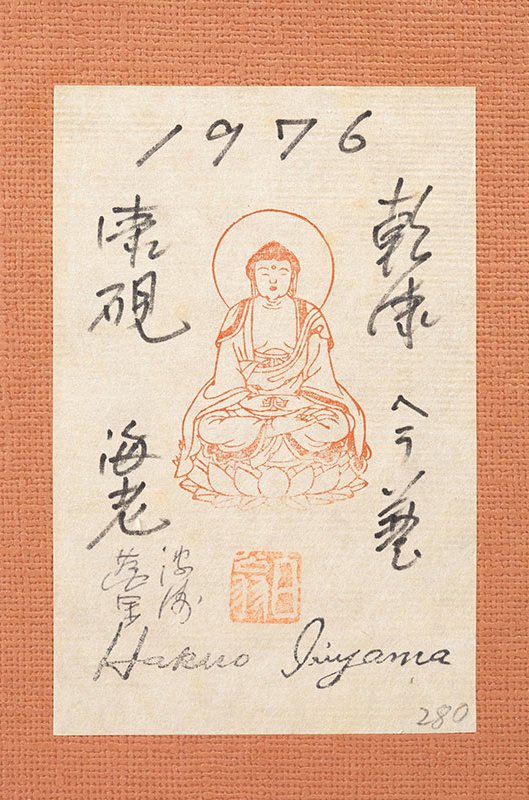POST-WAR & CONTEMPORARY
IRIYAMA HAKUO, KANSHITSU SUZURI WITH EBI OR ROCK LOBSTER
Suzuri or inkstone for calligraphy and painting in a hexagonal form, the upper surface ornamented in high-relief with an ebi or rock lobster; the reverse with deeply carved calligraphy within an irregular reserve: Hato Banri or Endlessly Billowing Waves. Of kanshitsu or dry lacquers, executed in black, the frame in orange-red and blue over black, Negoro style lacquers. Signed on the reverse with an incised and gold-lacquered signature by the artist: Hakuo (Iriyama Hakuo, 1904 – 1991). Showa 51 or 1976.
With the original fabric-covered paper storage box, with an applied paper label signed by the artist in English: Hakuo Iriyama; dated in Western style: 1976; and printed in red lacquer with an image of the Buddha seated in repose on a lotus; inscribed: Kanshitsu Heragei Shikken Ebi or Dry Lacquer Rock Lobster Inkstone (executed in) Heragei (technique); and then sealed. Iriyama Hakuo invented what he termed the Heragei technique in 1950, applying lacquer to a surface and carving it with a bamboo awl while it was only partially set.
Born to a family of lacquer artisans in Shirone City, Niigata Prefecture, Iriyama Hakuo moved to Tokyo in 1926 and began studying dry lacquer techniques. In 1928, he entered the lacquer department of the Ueno Bijutsu Gakko (now the Tokyo University of the Arts). In 1931, while still a student he first was accepted into the Bijutsu Kogei Ten (Fine Art & Craft Exhibition). The following year his work was accepted into the Bijutsu Kyokai Ten (Fine Art Association Exhibition), where it won a prize. In 1934, he traveled in Korea to study archaeological lacquers. The following year he exhibited a natsume summer tea caddy at the Fine Art Association Exhibition which won a prize and was purchased by the Empress Teimei. In 1939, Hakuo was accepted into the 3rd Shin-Bunten Exhibition, winning another prize, and in 1940 into the Hoshukuten. He participated in the 6th Shin-Bunten in 1943. After the Pacific War, he returned to the government-sponsored venues with the 1st and 2nd Nitten in 1946, the 4th in 1948, and the 6th in 1950, winning prizes each year.
After 1950, Iriyama Hakuo left the national exhibitions to continue as an independent artist. That year he experimented with new artistic lacquer techiniques: carving with bamboo unset or partly dried lacquer plates and applying pigments in what he termed shitsuga or lacquer painting; making lacquer prints with dry lacquer plates; and creating urushi-suzuri or lacquer inkstones from dry lacquer.
In 1954 and 1955, Hakuo sold various lacquer artworks abroad, including to the United States, United Kingdom, France, Germany, Argentina, the Netherlands, Belgium and the USSR (the Soviet Art Museum). A series of over 30 solo and group shows follow in the next decades, winning a prize at the Okinawa Expo ‘75’ for a large lacquer painting titled: Whirling Tides. In 1977, a 30 year retrospective of his work was mounted at the Tokyo Central Museum, followed in 1982 by a Guest Exhibition at the Shoto Museum of Art, and a solo show of his lacquer paintings at the Pasadena Museum of California Art. In 1984, he participated in an exhibition encompassing “500 Years of Artists Inspired by Mount Fuji,” at the Tokyo Fuji Art Museum. More solo shows followed in 1986, 1988 and in 1990. After his death in 1991, his work was included in “The Beauty of Lacquer” exhibition at the Meiji Shrine, Bunkakan Treasure Museum Annex, followed by a retrospective of his lacquer paintings at the Keio Plaza Hotel in 2006.
For another example of his work, c.f. Deco Japan: Shaping Art & Culture, 1920 – 1945, pages 120 – 121, number 47.
Iriyama Hakuo loved the tradition of arts for the scholar’s studio, especially inkstones. These he made with innovative techniques from kanshitsu or dry lacquer. Here the lobster’s back incorporates ground dry lacquer to achieve the rough texture for grinding sumi ink. Devoted to Zen Buddhism, he often combined iconography and calligraphy to echo this spiritual reading of life. According to his son, Iriyama Kiyoshi, what Hakuo meant by this suzuri can only be understood in this light. His calligraphy on the reverse, Hato Banri, loosely means Endlessly Billowing Waves, but it suggests that in life one meets long waves of anguish, sadness and suffering. The answer can only be to respond like the ebi does, with many limbs moving in whichever direction allows it to push forward, to persist and survive the raging seas of life. Hakuo frames his calligraphy with an irregular reserve, carving it with the point of a bamboo awl to resemble wood grain. This echoes the calligraphic placques traditionally hung in tea rooms or scholar’s studios, often of carved and gessoed wood, sometimes of sumi ink on mounted paper or silk. The artist frames the inkstone with brushed blue and red over black, echoing the tradition of Negoro lacquers which only show their beauty as one pigment wears away with time.
Iriyama Hakuo, Kanshitsu Suzuri with Ebi or Rock Lobster
Artist Name: Iriyama Hakuo
Period: Showa Post War
Mediums: Lacquer
Origin Country: Japan
1” high x 10 1/8” long x 7” wide
This piece is no longer available.





